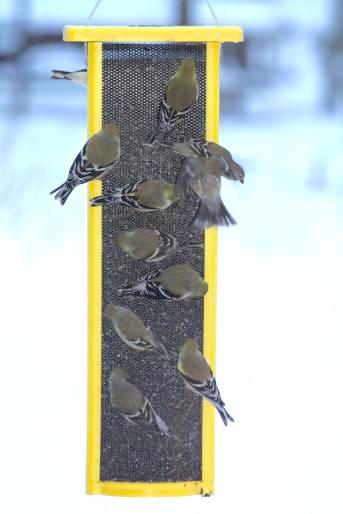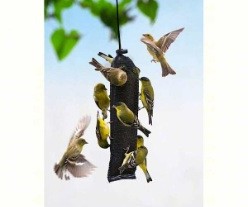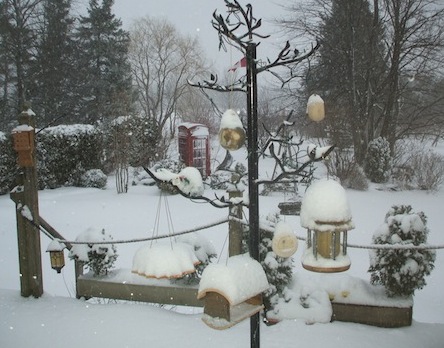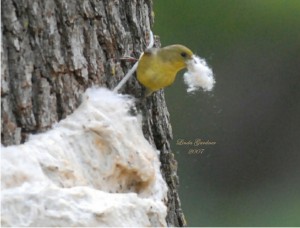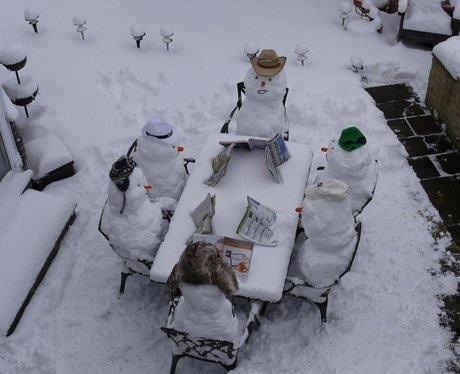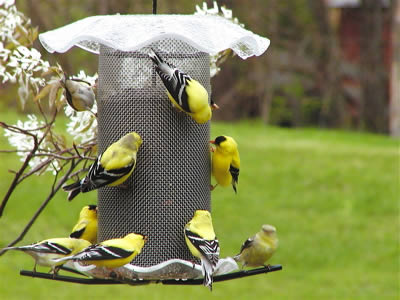-
The Late Frenzy Around Thistle Feeders
It’s an invasion of goldfinches… and pine siskins, and red polls and warblers and lots of other birds too lately! With the extreme cold weather, thistle feeders are being emptied at record rates, even Atlanta saw some of the white stuff, with more expected on Tuesday.
Birds seem ravenous around all of the feeders, and rightly so – it’s freakin’ freezing out there! With blustery winds and 12 degree temps a few days ago, my hands were not only numb… they actually hurt upon finishing the A.M. feeding routine. Placing them over a hot burner on the stove, then under hot water, I felt fairly sure it was frostbite 🙁
So how do they do it? Fragile, tiny little birds surviving the most frigid conditions, day in and day out? I don’t know! Looking like puff balls, their feathers do trap heat for one survival tactic, and if they constantly eat all day, they’re able
to store enough calories (energy) to hold them through the night. And yes, they can eat snow but it takes energy to convert it to liquid. Their daily struggle’s got to get old in these brutal winter conditions? Cardinals, bluebirds, woodpeckers, phoebes, a lone mockingbird, chipping sparrows and all the other usual suspects abound… and yet with snow on the ground!
But it’s really just instinct when you think about it. Mother Nature equips all beings with this basic survival mode. She also equips some of us with the lunacy that the birds won’t make it unless you put food out twice a day… and have 3 heated birdbaths readily available 🙂 But we do it not only for the birds, but for our own satisfaction of feeling like we helped, and the simple joy derived from watching them.
Should you reside anywhere old man winter’s got a death grip… please look out for feathered friends!
Keep feeders filled (and clean). Larger than normal bird populations crowding feeders is one way disease is spread.
Offer fresh water, birds will flock to a heated bath. You can purchase a heater separately and add it to your existing bath or even a shallow pan of water.
Put out extra suet, easily make your own, form into cakes for suet cages, or crumbles for platform or dish feeders. High fat foods that are easy to digest serve birds well in freezing weather.
Peanuts are ideal, as is plain old peanut butter. We smear some right on a tree trunk! Nuthatches, woodpeckers and warblers love it.
Add an extra thistle sock for the crowds of finches. Relatively inexpensive, the black mesh thistle feeders are stronger and generally more durable than most.
Stay safe and warm… and please feed the birds 🙂
Visit our site and save 10% on any birding items through 2/28.
Use promo code MC10.
Free shipping on $95 -
Thistle Feeders are in High Gear Once Again!
It may be officially summer, but the tail end of spring nesting season is still going strong. Goldfinches are just starting to nest now, which means you’ll be seeing a whole lot of yellow at thistle feeders in the next 2-3 months.
If you’re not offering thistle yet, you may be missing out! The American Goldfinch is a favored backyard songbird as their summer plumage, friendly disposition and sweet song are simply a pleasure to have around the garden. And unlike other birdseed, thistle seed won’t germinate… which is also a pleasure in the garden 🙂
Goldfinches don’t use birdhouses, so there’s no luring them in with that. They’ll raise their broods in mature hedges or trees, constructing nests of woven plant fibers and down. You can encourage them with some nesting materials placed in the vicinity of thistle feeders. They’re partial to Hummer Helper, the hummingbird nesting material, feathers and other fibrous nest offerings.
Unlike some more aggressive birds, goldfinches are quite demure, they’d rather fly off than fight for a spot at the feeder. This where lots of perches, or an all-over feeding space to accommodate them are ideal. Thistle socks are another great choice for goldfinches’ busy time of year. You can easily offer several different feeding spots, without spending a whole lot! Parents will feed babies thistle seed almost exclusively at first, sometimes mixed with finely chopped sunflower bits, you’ll see finches consuming this seed mix too.
As always, fresh water is critical to any bird’s environment. Keeping your bird bath clean is important stuff, for them and for your yard – especially in warm summer weather. Keep water shallow (no more than two inches) and keep it fresh… and they will come!
Oh wait, once goldfinches molt again in September they’ll turn an olive-drab color… but don’t quit feeding them. If you offer thistle year-round, their electric yellow plumage will grace your yard every summer!
-
Can You Spot the Thistle Feeders?
Me neither as they must be covered in snow and awaiting the big thaw. So this is April? Wisconsin, Minnesota, somewhere like that. Goldfinches are already shedding worn winter feathers and turning yellow, while other common resident birds are nesting in much of the country. Once again, will winter ever end?
Yesterday brought our first butterfly to the yard, but unfortunately the consecutive, way below normal night temperature this year zapped established lantana that was seven years old. You could always count on butterflies around those shrubs. Yes, that’s how big they were, mature shrubs.
Erratic weather is largely attributed to climate change, but many folks don’t see it that way. Mudslides, volcanoes, drought and rising sea levels to name a few effects are pretty apparent and scarily becoming the norm.
In the bluebird world, trail monitors found a record number of dead bluebirds in the KY area. A very late spring being the culprit after such a rough winter… there were simply no natural food sources available. Someone was inquiring about a feeder the other day and said “no rush, it’s for next year, we don’t really feed birds in summer”. We’ve come across many folks like that, but here’s the reality: weather directly affects food sources and bird’s survival rates.
Last summer through a wicked drought, we witnessed a male cardinal feeding a fledgeling from a platform feeder containing
sunflower hearts. From ground to platform and back he flew feeding his offspring. It was a strange sight, as others were reported this winter too. Cardinals hanging on suet feeders, and ground-feeding juncos up at black oil feeders. Many of the migratory birds were in for a harsh surprise upon arrival into the gulf states. No flowers, no berries, no insects, simply an equation for starvation after a long journey like that.
Closer to home, resident birds braved a very tough season as well. Feeders were non-stop with activity for the most part. Although thistle feeders didn’t see too much traffic, other feeders containing finch mixes did… and a lot! Once the olive drab fliers began their molting process, straight nyjer became goldfinches’ food of choice and overnight, thistle was and is being devoured daily!
The good news is this seed has come down in price a little bit, and if you can manage the larger bags, like 20-to 40-pounders, you’ll save even more money this summer. Unlike other birds, goldfinches feed nestlings and fledgelings thistle-almost exclusively.
So if you’re not really a “summer feeder”, you may want to rethink maybe just one or two feeders this summer… the bird families sure will thank you!

